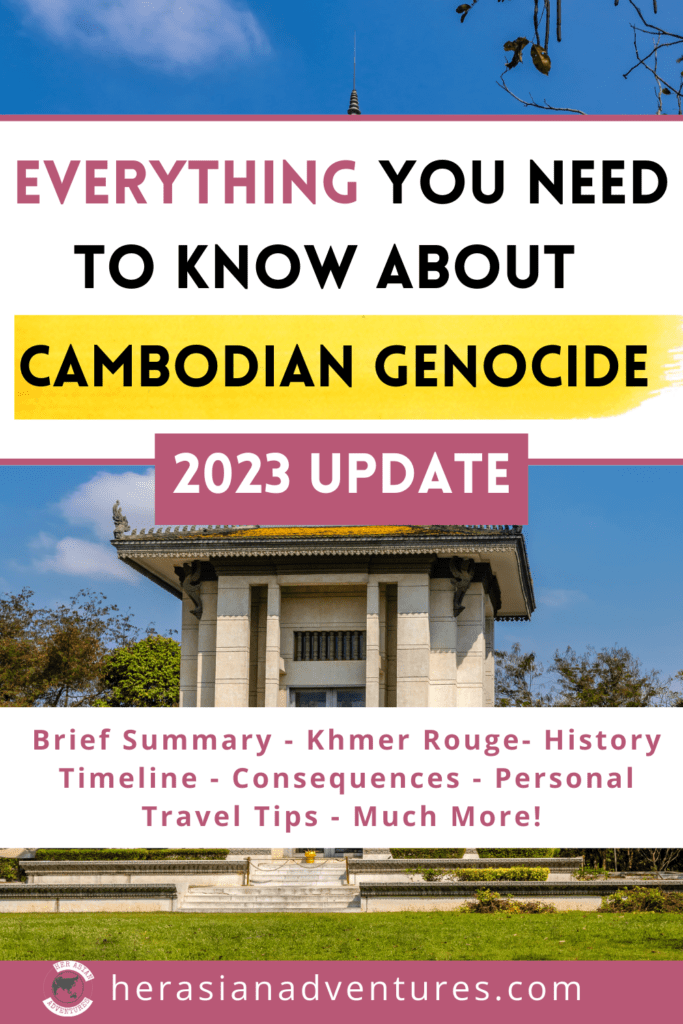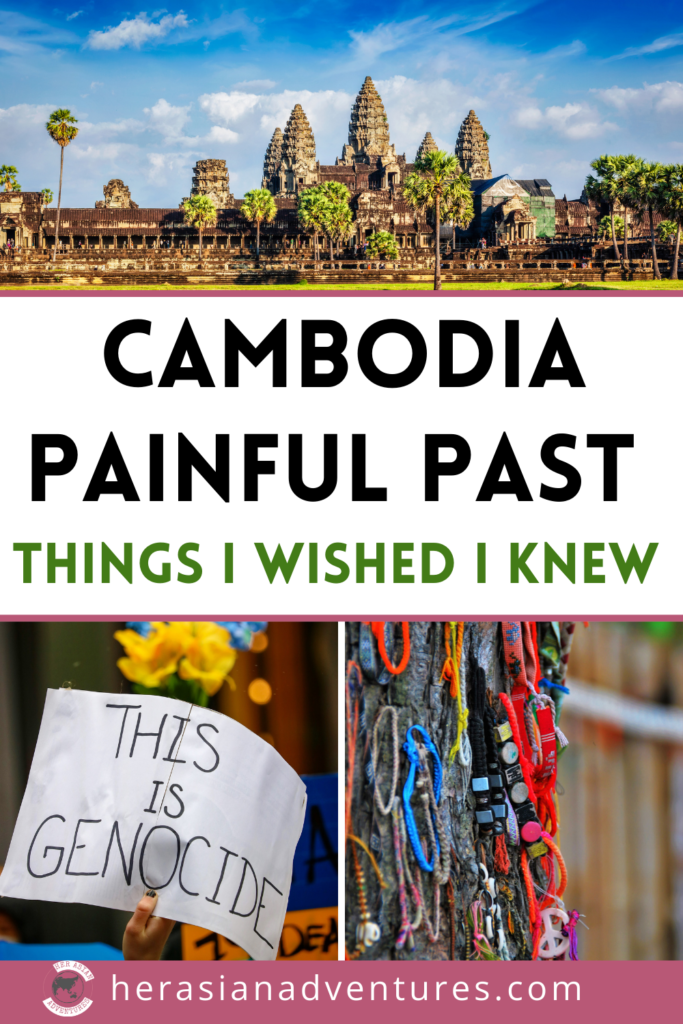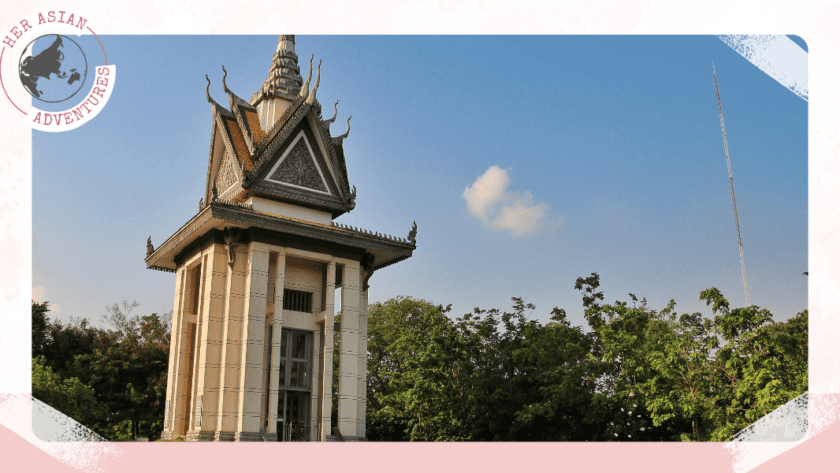Beyond the warm smiles and stunning ancient temples of Cambodia, lies a history of unimaginable pain and remarkable strength.
In this travel blog post, we’re about to embark on a journey through Cambodia’s heart-wrenching past.
We’ll explore the stories of S21 prison and the Killing Fields, where unimaginable tragedies unfolded.
Now, I’ll be honest, this day can stir some deep emotions. Yet, it’s an essential step towards truly understanding Cambodia’s vibrant culture today and making sure its history is never forgotten.
My advice? Don’t make the same mistake I did. Take the time to learn about the Cambodian genocide before stepping foot in this incredible country.
Let’s get started!
- Cambodian Genocide: Timeline and Basic Facts
- Understanding the Cambodian Genocide: A Personal Perspective
- The Dark Era of the Khmer Rouge: An Agrarian Utopia
- From Capital to Countryside: The Horrors Unleashed
- The Aftermath and Never Forgetting
- Visit the S-21 Prison and the Cambodia Killing Fields
- S-21 Prison: Cambodian Genocide Museum
- Cambodia Killing Fields
- Reflections and Remembrance
- Cambodian Genocide Summary
Cambodian Genocide: Timeline and Basic Facts
Understanding the Cambodian Genocide: A Personal Perspective
Before we start exploring those famous historical sites, let’s take a minute to really grasp some key facts about Cambodia’s history and the dark chapter of the Khmer Rouge regime.
Now, I’ll be the first to admit, I’m no history expert. But after my last backpacking trip in Southeast Asia, I decided to dig deeper into the horrors of the Cambodian genocide.
I genuinely urge you to do the same. Whether it’s through official accounts, a well-researched book, or even an unbiased podcast, taking this step is important in honoring the memory of those affected by this unimaginable tragedy.
You can learn more about Cambodia history timeline on this website


The Dark Era of the Khmer Rouge: An Agrarian Utopia
The Cambodian Genocide, which took place from 1975 to 1979, was one of the darkest period in Cambodia’s history.
Led by Pol Pot, the brutal Khmer Rouge regime came into power after the Vietnam War with one main goal – to create an agrarian utopia.
Their vision was nothing short of radical, picturing a communist state without societal classes, and the complete abolition of private property.
They went so far as to destroy their own machinery, hospitals, temples, and infrastructure, erasing any trace of what they viewed as imperialistic influence.
To delve deeper into the ideology of the Khmer Rouge, I recommend checking out this website

From Capital to Countryside: The Horrors Unleashed
Cast your mind back to April 17, 1975, a day that changed everything. The Khmer Rouge quickly took control of the capital, emptying its streets within a matter of hours.
The entire population was sent to the countryside where they faced forced labor, malnutrition, and brutal living conditions.
As days turned into years, the horrors only intensified. Thousands died from torture, disease, and starvation.

Reasons to Die During the Cambodian Genocide
The regime’s brutality spared no one—be they intellectuals, professionals, or religious leaders. Even those with the faintest ties to the previous government were hunted down.
You could be killed for wearing glasses, holding a university degree, speaking multiple languages, having soft hands, or even playing a musical instrument. It was a level of cruelty that’s almost impossible to imagine.
Their twisted belief? “Better to mistakenly kill an innocent than let an enemy live”
This led the Khmer Rouge to frequently wipe out entire families if even one member was considered a potential threat, all in the name of “eliminating the root.”


The Aftermath and Never Forgetting
In 1979, Vietnamese forces invaded Cambodia, bringing an end to the Khmer Rouge’s brutal reign and pushing them into guerrilla warfare.
The passing of Pol Pot in 1998 marked the end of a dark era, although other leaders would face trials in the 2010s, ensuring some accountability for the atrocities committed.
This period stands as one of the most devastating genocides in recent history, claiming nearly two million lives – nearly a quarter of Cambodia’s entire population.
Take a moment to let that sink in. Imagine a quarter of your country’s population wiped out in just four years, less than 50 years ago.
This is the unimaginable tragedy that Cambodia endured, and it’s a history that we must never forget.
Continue Reading: The Rise and Fall of the Khmer Rouge
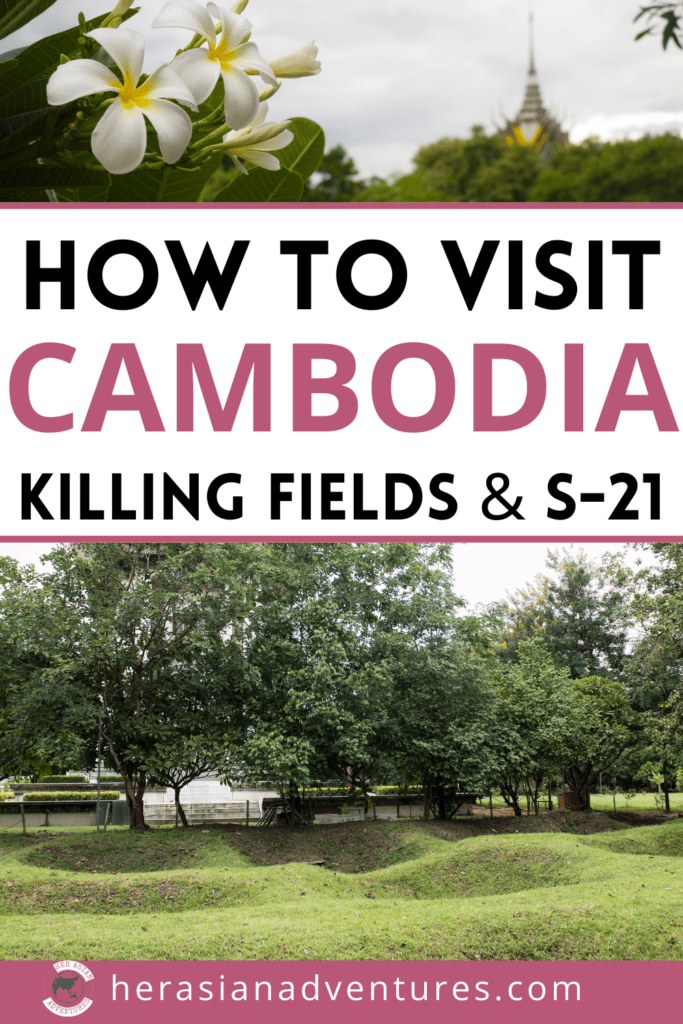
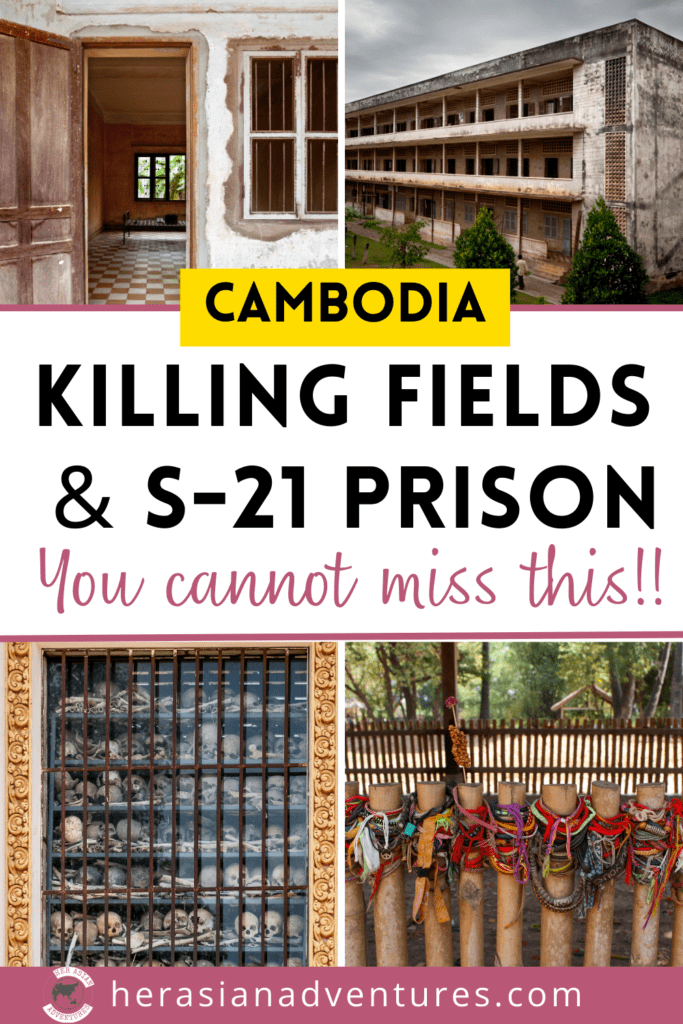
Visit the S-21 Prison and the Cambodia Killing Fields
Now that we know the basic Cambodia history facts, let’s talk about the two crucial historical sites: the S-21 Prison and the Cambodia Killing Fields.
Trust me, this is an absolute must-do when you’re in Phnom Penh. It might be tough, but you won’t regret it.
You can cover both places in a single day, or even in a morning.
I booked a tuk-tuk tour with a group directly through my hostel (Onderenz Hostel), and it made the whole experience super easy and hassle-free. You can find more details about the tour on their website.
During the tour, please be polite. Keep your voice down, and avoid laughing or playing loud music. Just bear in mind, the person beside you might have lost a parent or grandparent in this massacre.
Also, no matter your budget: invest in the audio guide. Even if there’s an extra cost, I promise you, it’s worth every penny.
Without it, you might find it difficult to truly understand the significance of what you’re witnessing.


S-21 Prison: Cambodian Genocide Museum
Our journey kicked off at the Tuol Sleng Genocide Museum, once known as S-21 Prison, located right in the heart of Phnom Penh.
I can’t put into words the weight of history that hangs over that place—it’s truly unimaginable.
Once a high school, this unassuming complex was turned into a nightmarish detention center by the Khmer Rouge regime.
They say that 12,000 to 20,000 people died within these walls, but the records were deliberately destroyed.
What’s even more astonishing is that even today, families are still discovering photos of their lost loved ones.
And if you want to, for a fee, you can even meet one of the twelve S-21 survivors. Learn more about the Cambodian genocide survivors here

S-21 Torture Methods
The moment prisoners stepped into those claustrophobic cells, there was no stepping out.
They were coerced into confessing to anything and everything, from alleged ties with the CIA to the KGB.
Days were spent in chains, enduring unspeakable terrors – hangings, electric shocks, beatings… It was truly heart-wrenching.
Even now, as you explore the S-21 prison, you’ll come across remnants of those unimaginable acts – rusty shackles, bone-chilling torture devices, and the haunting remains of interrogation rooms.
Listening to the stories of S-21 survivors through the audio guide while standing in those very rooms, it’s definitely an overwhelming experience.
Yet, it’s also proof that even in the darkest of times, resilience and hope can prevail.
Continue Reading: How To Stay Connected While Traveling Solo: Local SIM cards


Faces of Tragedy: The Prisoner Portraits.
Stepping into S-21, one exhibit hit me particularly hard—the gallery of prisoner portraits.
These haunting black-and-white photographs give a face and a name to those who were tortured here.
Men, women, children, foreigners – no one was shielded from this horror.
Each gaze in those photographs carries a mixture of fear, resignation, and an unbreakable spirit in the face of death.
It’s a stark and brutal reminder that behind every statistic, there’s a life, a family, and a story that must never be forgotten.


Cambodia Killing Fields
Leaving S-21 behind, our next stop takes us to the Choeung Ek Genocidal Center, famously known as the Cambodia Killing Fields.
Stepping into this peaceful garden, it’s nearly impossible to imagine the horrors that unfolded here not too long ago.
For a truly immersive experience, I can’t recommend the audio guide enough.
Narrated by survivors, it provides a vivid and deeply personal account of the atrocities that took place.
Picture this: In the mornings, the air would be filled with music and propaganda messages, a desperate attempt to drown out the harrowing sounds of beatings – a brutal method employed to conserve bullets. It’s chilling to think about.


Navigating the Cambodia Killing Fields
As you walk through the grounds, you’ll come across small mounds, each marking a mass grave where countless individuals were laid to rest.
Even today, the rain occasionally reveals haunting reminders as skulls and bones emerge from the earth.
One cannot help but be moved by the Killing Tree, against which babies were brutally silenced. It’s just another example of the depths of unspeakable cruelty that were reached.
At the center of the Killing Fields stands a towering memorial stupa, housing over 5,000 human skulls.
It is a powerful tribute to those who lost their lives and a plea for a world where such atrocities never happen again.
Continue reading: Survivors of Cambodia’s Killing Fields


Reflections and Remembrance
I won’t lie, my visit to S-21 and the Cambodia Killing Fields was emotionally draining. It’s impossible to leave these sites untouched.
I mean, tears were flowing pretty much the entire time, and that’s not something you’ll catch me doing every day, even at places like Auschwitz.
It’s astonishing to think that all of these horrors happened less than 50 years ago, and I, like many, had absolutely no idea. It really makes me wonder what else I might have overlooked in my education.
I can’t help but regret not learning about the Cambodian genocide before landing here. Lesson learned – I’ve promised myself to always dig into a country’s past before any future trip.
Yet, amid all the heartache, I was struck by the incredible resilience of the Cambodian people. Today, Phnom Penh is a city that refuses to be defined by its tragic past.
The lively markets, the bustling riverfront, and the warm smiles of its locals stand as a testament to the astonishing strength and hope that resides within each of us.
Continue Reading: +20 Travel Safety Items for Solo Female Travelers


Cambodian Genocide Summary
Cambodia’s history is a powerful reminder of both the depths humanity can sink to, and our incredible capacity for healing and rebuilding.
Today, it’s more important than ever to remember and learn from these unspeakable atrocities, ensuring they never happen again, anywhere in the world.
So, if you ever have the chance to visit Cambodia, I wholeheartedly encourage you to visit these historical sites.
Let’s not just honor the past, but also work towards a brighter future—for Cambodia and for the entire world.
Together, we can make a difference!

P.S.- If this story has touched you or inspired you to learn more, please share your thoughts in the comments below. Your voice helps us reach more people
Like it? Save it On Pinterest!
